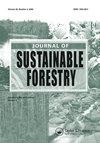埃塞俄比亚西南部Gura-Ferda地区天然林与农田转换梯度木本物种多样性和碳储量的比较
IF 1.8
4区 农林科学
Q3 FORESTRY
引用次数: 3
摘要
摘要:古拉-费尔达森林是埃塞俄比亚西南部潮湿的常青非洲山地森林的一部分。尽管自1984年以来,这片森林的大部分变得越来越混乱和支离破碎,但没有关于木本物种多样性和森林碳库动态的科学数据。因此,本研究旨在评估和比较天然林-农田转换梯度沿线木本物种和碳储量的多样性。数据是从天然林、林场界面和以前属于林地的农田中收集的。对于木本物种的清查,建立了90个嵌套地块(天然林和林场界面为20m*20m;农田为50m*100m)。为了收集垃圾和土壤样本,建立了三个1m*1m的亚地块。天然林(H’=2.72±0.31)的Shannon Wiener多样性指数显著高于林场界面(H’=1.42±0.49)和农田(H’=10.8±0.57)。天然林总碳储量分别是林场界面和农田的1.55和2.64倍。这项研究表明,沿着天然林向农田的转换梯度,物种多样性和碳储量大幅减少。该地区的自然资源管理部门应采用管理方法来减轻天然林的压力,因为天然林向农田转换的梯度导致了物种丰富度和碳储量的大幅下降。本文章由计算机程序翻译,如有差异,请以英文原文为准。
Comparison of Woody Species Diversity and Carbon Stock along Natural Forest to Farmland Conversion Gradient in the Gura-Ferda District of Southwestern Ethiopia
ABSTRACT Gura-Ferda forest is part of the moist evergreen Afromontane forest in southwestern Ethiopia. Despite the fact that large sections of this forest have become increasingly disturbed and fragmented since 1984, there is no scientific data on the dynamics of woody species diversity and forest carbon pools. As a result, the research was carried out to assess and compare the diversity of woody species and carbon stock along natural forest to farmland conversion gradient. Data were collected from natural forest, forest-farm interface, and farmland that were previously forest land. For the inventory of woody species, 90 nested plots (20 m*20 m for natural forest and forest-farm interface; 50 m*100 m for farmland) were established. To collect litter and soil samples, three 1 m*1 m subplots were established. Shannon-Wiener diversity index is significantly higher (p < .05) in natural forests (H’ = 2.72 ± 0.31) than in forest-farm interface (H’ = 1.42 ± 0.49) and farmland (H’ = 1.08 ± 0.57). Natural forest total carbon stocks were approximately 1.55 and 2.64 times higher than forest-farm interface and farmland, respectively. This study revealed that there was a substantial reduction in species diversity and carbon stocks along the conversion gradient of natural forest to farmland. The Natural Resource Management sector of the district should use management approaches to reduce the pressure on natural forest, which has resulted in a substantial decrease in species richness and carbon stocks along the natural forest to farmland conversion gradient.
求助全文
通过发布文献求助,成功后即可免费获取论文全文。
去求助
来源期刊

Journal of Sustainable Forestry
Social Sciences-Geography, Planning and Development
CiteScore
3.90
自引率
12.50%
发文量
42
期刊介绍:
Journal of Sustainable Forestry publishes peer-reviewed, original research on forest science. While the emphasis is on sustainable use of forest products and services, the journal covers a wide range of topics from the underlying biology and ecology of forests to the social, economic and policy aspects of forestry. Short communications and review papers that provide a clear theoretical, conceptual or methodological contribution to the existing literature are also included in the journal.
Common topics covered in the Journal of Sustainable Forestry include:
• Ecology, management, recreation, restoration and silvicultural systems of all forest types, including urban forests
• All aspects of forest biology, including ecophysiology, entomology, pathology, genetics, tree breeding, and biotechnology
• Wood properties, forest biomass, bioenergy, and carbon sequestration
• Simulation modeling, inventory, quantitative methods, and remote sensing
• Environmental pollution, fire and climate change impacts, and adaptation and mitigation in forests
• Forest engineering, economics, human dimensions, natural resource policy, and planning
Journal of Sustainable Forestry provides an international forum for dialogue between research scientists, forest managers, economists and policy and decision makers who share the common vision of the sustainable use of natural resources.
 求助内容:
求助内容: 应助结果提醒方式:
应助结果提醒方式:


